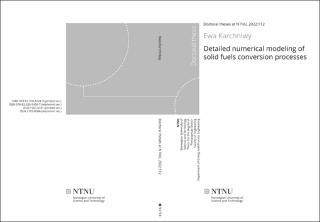| dc.contributor.author | Karchniwy, Ewa | |
| dc.date.accessioned | 2022-04-25T09:11:49Z | |
| dc.date.available | 2022-04-25T09:11:49Z | |
| dc.date.issued | 2022 | |
| dc.identifier.isbn | 978-82-326-5456-7 | |
| dc.identifier.issn | 2703-8084 | |
| dc.identifier.uri | https://hdl.handle.net/11250/2992444 | |
| dc.description.abstract | This thesis investigates conversion of solid fuel particles from different perspectives. In particular, two aspects of the conversion process are studied: 1) the effect of turbulence on the conversion rate and 2) the combustion behaviour of a single carbon particle.
Direct Numerical Simulations of polydisperse particle systems in a periodic box of isotropic and homogeneous turbulence were performed in order to analyse how turbulence affects the mass transfer rate in such configuration. The effect of turbulence was found to be identical qualitatively and very similar quantitatively to what was observed for monodisperse particle systems, i.e. there exist two opposing mechanisms through which turbulence can affect the reactant transfer to surfaces of particles. The first mechanism leads to formation of particle clusters, which are responsible for decreased mass transfer rate, while the other is associated with the mass transfer being enhanced by turbulent motions. The model which accounts for the combined effect of turbulence was shown to be applicable to polydisperse particle systems. The effect of particle back-reaction was also studied, the results revealed its importance especially in cases characterized by high Stokes numbers. A sensitivity of the effect of turbulence to selected parameters was investigated through theoretical analysis and using simple numerical examples. Several parameters (mixture composition, particle material, turbulence intensity, particle size, mass flow rate) were demonstrated to have a meaningful influence on how strong the effect is. Finally, the effect of turbulence on the conversion rate in practical systems was examined. For this purpose, an industrial-scale boiler was simulated in ANSYS Fluent. The results showed that regions of very different conditions can simultaneously occur in different parts of the boiler, which rules out the possibility to predict the net effect of turbulence a priori. Moreover, it was shown that the conversion rate might be affected by turbulence much less than expected based on theoretical predictions as the reaction rate is often controlled by kinetics, i.e. it is independent on the rate of reactant transfer.
A simple model for the resolved carbon particle conversion was implemented in the Pencil Code. Efficiency of the model was achieved by pre-adjustment of diffusion coefficients, reduction of the speed of sound and employment of a semi-global mechanism. Despite numerous simplifications, an ability of the model to predict main characteristics of the char particle conversion and formation of a flame zone was demonstrated by validating the model against experimental and numerical results. Sensitivity of the conversion rate to kinetic parameters and transport coefficients was studied. A strong sensitivity to the oxygen diffusivity was registered, especially at higher temperatures. | en_US |
| dc.language.iso | eng | en_US |
| dc.publisher | NTNU | en_US |
| dc.relation.ispartofseries | Doctoral theses at NTNU;2022:112 | |
| dc.relation.haspart | Paper 1: Karchniwy, Ewa Malgorzata; Klimanek, Adam F.; Haugen, Nils Erland L. The effect of turbulence on mass transfer rates between inertial polydisperse particles and fluid. Journal of Fluid Mechanics 2019 ;Volum 874. s. 1147-1168 https://doi.org/10.1017/jfm.2019.493 | en_US |
| dc.relation.haspart | Paper 2: archniwy, Ewa Malgorzata; Haugen, Nils Erland L; Klimanek, Adam F.; Langørgen, Øyvind; Sladek, Slawomir. The effect of turbulence on mass transfer in solid fuel combustion: RANS model. Combustion and Flame 2021 ;Volum 227. s. 65-78
https://doi.org/10.1016/j.combustflame.2020.12.040
This is an open access article under the CC BY license | en_US |
| dc.relation.haspart | Paper 3: Karchniwy, Ewa Malgorzata; Haugen, Nils Erland L; Klimanek, Adam. A numerical study on the combustion of a resolved carbon particle.
The final published version is available in:
Combustion and Flame 2021 ;Volum 238.
https://doi.org/10.1016/j.combustflame.2021.111880
This is an open access article under the CC BY | en_US |
| dc.title | Detailed numerical modeling of solid fuels conversion processes | en_US |
| dc.type | Doctoral thesis | en_US |
| dc.subject.nsi | VDP::Technology: 500::Environmental engineering: 610 | en_US |
